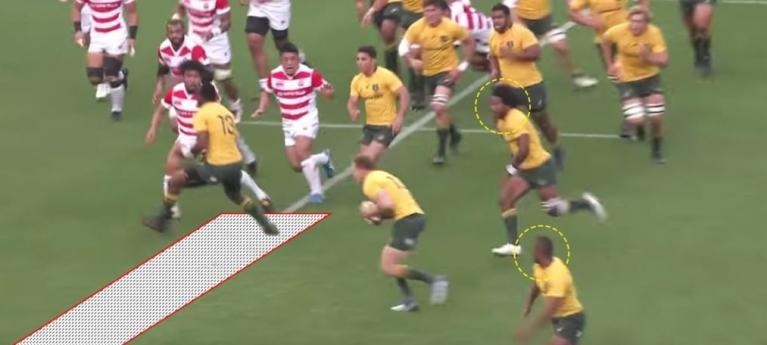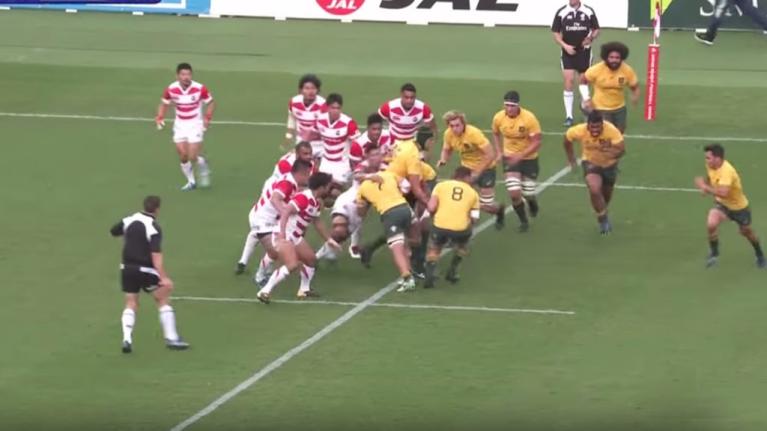Analysis: How the Wallabies 'fake maul' set up Speight's try

The Wallabies head to Millennium Stadium this Saturday, and it's fair to say the Welsh defence will pose a much harder task this weekend than the Japanese Brave Blossoms did over the weekend. The Australians triumphed 63-30, and it will be tougher to find and isolate weak defenders like they did on this set piece lineout move. However, this play illustrated the Wallabies still have some ingenuity in their playbook.
This lineout play starts with a well designed ‘fake’ maul, with Sean McMahon (8) looking to bind on Coleman before breaking off and feeding the halfback Phipps. McMahon’s ‘trap’ freezes or engages members of Japan’s forwards, which will play a big part in getting the one-on-one matchup Australia wants.

Japan’s pack is caught crowding the fake maul, and the key loose forwards Michael Leitch (6) and more specifically Nunomaki (7) are still stationary. Neither of the two has started tracking towards the backs to provide cover defence.
Phipps is tasked with making an option read on a simple screen, to either hit Kuridrani (13) flat on a crash or provide the ball out the back to makeshift first five-eighth Hodge (10), however on this play Kuridrani is used as a decoy. We can also see the blind winger Speight is looming as an inside option for Hodge.
Kuridrani’s decoy line is going to effectively block these defenders from being able to touch Speight, much like a ‘rub’ play in the NFL by engaging in light contact and forcing them to either go around him over or under, giving Speight a window of opportunity.
As Hodge receives the ball, Kuridrani is blocking the path of the cover defence. Hodge now has two options highlighted, Speight inside and Beale outside.
Japan’s first five-eighth Matsuda has made a bad read by biting on the Kuridrani line when he had inside cover and is now trying to recover back. Hodge is showing his hand early, hips squared and ball out ready to feed Speight on the inside with no other defenders yet in the picture.
Hodge’s pass is released a touch too early, but he still managed to commit his opposite into contact. A better defender may have read the inside option coming and kept both tackle decisions open. Kuridrani has done his job perfectly, causing a traffic jam amongst Japan’s forwards. Speight is now one-on-one at full speed against a back-peddling Matsuda.
Matsuda is no match for Speight’s power & speed and struggles to put a finger on him. The play design did a good job of isolating him in a one-on-one situation against a power athlete, but Japan’s decision-making nous was lacking in this case.
This will be the difference between Japan and Wales, the defensive reads will be better and the gaps will be smaller. On this occasion, the Wallabies deserve credit but the execution but will require just a touch more polish to pull off the same move against a more distinguished side.
However, it looks like they may have got inspiration for the move from the All Blacks who used a very similar play in the third Bledisloe test. The All Blacks start the play with a fake maul and have Sonny Bill Williams run the decoy line before Waiseke Naholo makes the line break.
They say imitation is the sincerest form of flattery.


Latest Comments
Another solution would be to move the schedule a week later - there’s a month long break before the Rugby Championship so why would the NZRU schedule the first game in conflict with a major club final?
Once you remove the scheduling issue - it becomes purely about player welfare and that’s the French unions issue to deal with. The whole idea of becoming the best team is moot if you cede all your national power to a club competition.
Go to commentsExactly, Moana is entirely a NZ side and it the second Auckland franchise. Its the only side in the world that's been setup for the alleged purpose of developing players for two other ‘countries’ from playing talent from another country.
In reality it's best players are always going to be picked for the Allblacks as they're eligible kiwis. That's never going to change so the best thing to do is stop the pretence and make the team just another NZ super franchise that isn't ethnically based to allow talent equal access to professional contracts regardless of their ethnicity.
Commentaries claiming players from this team need to be ignored by the Allblacks selectors are of course advocating for the ridiculous situation that NZ becomes the only rugby country that overlooks players born and living in that country with that countries citizenship.
Go to comments